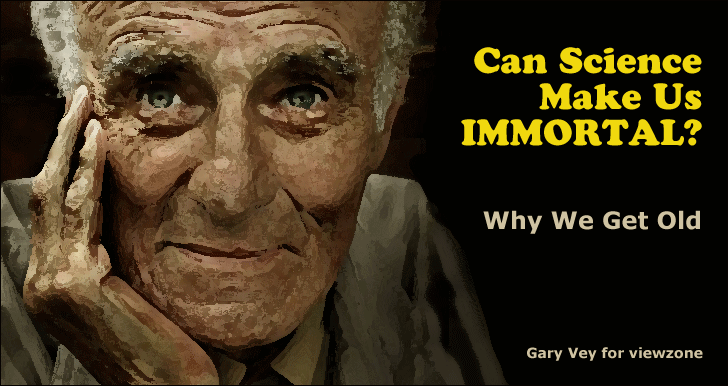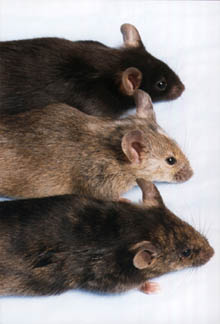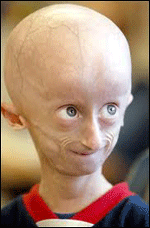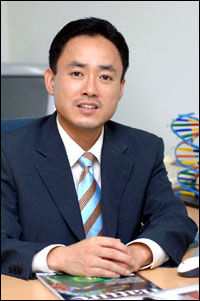center> Is Human Immortality A Scientific Reality?
CONTINUED...
A New Player: Progerin?
Progerin stems from a gene mutation that shows up in abundance in the disease but in more manageable quantities in all of us. It causes extreme premature aging.
"When the telomeres become too short and frayed, this triggers the production of progerin, signaling to the body that the cell is at the end of its useful life." -- Dr. Francis Collins, director of the National Institutes of Health Studies are underway to block the excess production of the protein in children with progeria, which may in turn lead to slowing our own aging and preventing age-related diseases such as cancer, heart disease, and Alzheimer's.[10] Rust Never Sleeps DNA damage occurs continuously in living cells. While most of this damage is repaired, some accumulates. The DNA Polymerases and other repair mechanisms cannot keep up with defects as fast as they are produced. In particular,DNA damage accumulates in non-dividing cells of mammals [13], but all cells eventually need to reproduce and let their "other half" carry on.
Most damage comes in the form of oxidative damage -- the same "rusting" process that oxidizes irong. Arteriosclerosis and heart disease are the results of this type of damage to the cells lining the blood vessels. Without the ability to duplicate and repair itself, the cell "rusts" to death. In this way we gradually lose members of our youth -- one cell at a time. We wear out and become a mortal. Is Long Life Inherited? If your family has a history of living to an old age, it is likely that your telomeres are longer and therefore protect the critical DNA information when your cells make copies of themselves. In a general population, the people who live longer usually have more offspring. So it follows that the number of people having longer telomeres would increase. But there's the cancer problem. The immortal cancerous cells that we all produce outlive normal cells and eventually express themselves in tumors, shortening life. These two opposing consequences of long telomeres, positive and negative, are balanced by natural selection. The compromise is currently programmed for an average life expectancy of 76 years. Environmental Factors? Our cells are bombarded by environmental poisons that can cause the genetic codes to break, regardless of the telomere length. The more toxic the environment is, the greater the chance for "broken" cells to reproduce themselves and the more beneficial it would be to have shorter telomeres to limit this kind of mutation. What would happen if a population was forced to have offspring at a very young age, eliminating the impact of a toxic environment? This is exactly what happens to laboratory rats and mice who are artificially bred. Their breeding environment is usually free of toxins and highly controlled, thus favoring the expression of longer telomeres. This fact is important because rats and mice are traditionally used to test for toxicity of products in humans. In short: the rats may be too healthy to be our experimental surrogate. Beware of Lab Rat Inferences
 Bret S. Weinstein & Deborah Ciszek [University of Michigan] observed that captive-rodent breeding protocols, designed to increase reproductive output, simultaneously exert strong selection against reproductive senescence (old age) and virtually eliminate selection that would otherwise favor tumor suppression (i.e. having shorter telomeres). This appears to have greatly elongated the telomeres of laboratory mice. With their telomeric failsafe effectively disabled by forced breeding techniques, these animals are unreliable models of normal senescence and tumor formation. Safety tests employing these animals likely overestimate cancer risks and underestimate tissue damage and consequent accelerated aging. In short: lab rats are bred in an artificial environment that does not allow for the changes of natural selection and so they have become more prone to cancer and artificially immune to the effects of premature aging. As such, their reaction to pathogens should not necessarily be relied upon to indicate human reactions to such things as food additives, radiation and environmental contaminants. This is a serious problem that has, so far, received little acknowledgement. While we effectively test products for causing cancer we risk the mistake of permitting products that can make us age faster. Children of young mothers live longer It has also been noted that children of young mothers seem to live longer than children of older mothers. This is because all of the eggs of a female are produced while she is still in her mother's womb. She is born with all of the egg cells that she will ever have. The telomeres of the early produced eggs are very long but become shortened as more are made. So a woman has a finite number of eggs, some with long telomeres and some with shorter telomeres. After birth, when the female reaches puberty, these long-telomere egg cells are the first to be released by the ovaries, and the first to become potential embryos. Thus, having children as near to puberty as possible increases the chance that the offspring will inherit long telomeres. It also explains why having children later in life increases the chance for birth defects or miscarriages. This is precisely what is happening to the laboratory rat and mice populations, who are forced to breed early, and explains why these lab animals have unusually long telomeres compared to animals in the general "wild" population. Conclusions So for humans to extend life we must do two things: first, eliminate the toxins in our environment that rust the cells. Remember the hayflick limit. A toxic environment can run through those allotted duplications at an accelerated rate. Next we wait for a scientific breakthrough -- perhaps some pharmaceutical that will re-activate telomere production in healthy cells only. Understanding and controlling telomeres in healthy and cancerous cells will lead to a cure or prevention of cancer. If mortality still eludes us, at least that will greatly extend our lives. The twenty-first century may well be the era in which humans learn the secrets of eternal life, but it may also be a time to be reminded of the many dangers inherent in exploring and exploiting these god-like abilities.
From every tree in the garden did he grant them to eat, save but one. And that tree, in the center of the garden, was called the tree of life. And the Snake said to Eve, "Eat of this fruit and you will become as God and never die.-- Genesis 3:1

 Notes: [1] Steven E. Artandi, Dept of Hematology, Cancer Biology Program, Stanford University School of Medicine, Trends in Molecular Medicine, Volume 8, Issue 1, 1 January 2002, Pages 44-47 [2] Telomere elongation in immortal human cells without detectable telomerase activity, T M Bryan, A Englezou, J Gupta, S Bacchetti, and R R Reddel Cancer Research Group, Children's Medical Research Institute, Westmead, Sydney, NSW, Australia. [3] Ohyashiki K, Ohyashiki J, Iwama H, Hayashi S, Shay J, Toyama K.,Telomerase reactivation in leukemia cells, Int J Oncol. , 1996 Mar;8(3):417-21. [4] Thanks to Thomas R. Cech, Steven A. Jacobs and Elaine R. Podell of the Howard Hughes Medical Institute, University of Colorado at Boulder. [5] Motonobu Katoh, Misaki Katoh, Michihiro Kameyama, Hiroyuki Kugoh, Motoyuki Shimizu, Mitsuo Oshimura, A repressor function for telomerase activity in telomerase-negative immortal cells, Molecular Carcinogenesis, Volume 21, Issue 1, pages 17–25, January 1998 [6] T M Bryan, A Englezou, J Gupta, S Bacchetti, and R R Reddel, Telomere elongation in immortal human cells without detectable telomerase activity, EMBO J. ,1995 September 1; 14(17): 4240–4248. [7] Steven E. Artandi, Telomere shortening and cell fates in mouse models of neoplasia, Trends in Molecular Medicine,Volume 8, Issue 1, 1 January 2002, Pages 44-47 [8] Calvin B Harley and Bryant Villeponteau, Telomeres and telomerase in aging and cancer, Current Opinion in Genetics & Development, Volume 5, Issue 2, April 1995, Pages 249-255 [9] Fajkus et al., 1996; Fitzgerald et al., 1996; Heller et al., 1996 [10] http://www.frontsidebus.net/2011/06/15/slow-down-new-research-suggests-a-treatment-for-aging/ [11] The Plant Cell, Vol. 16, 794–803, April 2004, www.plantcell.org 2004 American Society of Plant Biologists, HISTORICAL PERSPECTIVE ESSAY: Plant Telomere Biology UPDATE: Harvard scientists reverse the ageing process in mice -- now for humans Harvard scientists were surprised that they saw a dramatic reversal, not just a slowing down, of the ageing in mice. Now they believe they might be able to regenerate human organs Laboratory mouse in a scientist's hand In mice, reactivating the enzyme telomerase led to the repair of damaged tissues and reversed the signs of ageing. Scientists claim to be a step closer to reversing the ageing process after rejuvenating worn out organs in elderly mice. The experimental treatment developed by researchers at the Dana-Farber Cancer Institute, Harvard Medical School, turned weak and feeble old mice into healthy animals by regenerating their aged bodies. The surprise recovery of the animals has raised hopes among scientists that it may be possible to achieve a similar feat in humans -- or at least to slow down the ageing process. An anti-ageing therapy could have a dramatic impact on public health by reducing the burden of age-related health problems, such as dementia, stroke and heart disease, and prolonging the quality of life for an increasingly aged population. "What we saw in these animals was not a slowing down or stabilisation of the ageing process. We saw a dramatic reversal – and that was unexpected," said Ronald DePinho, who led the study, which was published in the journal Nature. "This could lead to strategies that enhance the regenerative potential of organs as individuals age and so increase their quality of life. Whether it serves to increase longevity is a question we are not yet in a position to answer." The ageing process is poorly understood, but scientists know it is caused by many factors. Highly reactive particles called free radicals are made naturally in the body and cause damage to cells, while smoking, ultraviolet light and other environmental factors contribute to ageing. The Harvard group focused on a process called telomere shortening. Most cells in the body contain 23 pairs of chromosomes, which carry our DNA. At the ends of each chromosome is a protective cap called a telomere. Each time a cell divides, the telomeres are snipped shorter, until eventually they stop working and the cell dies or goes into a suspended state called "senescence". The process is behind much of the wear and tear associated with ageing. At Harvard, they bred genetically manipulated mice that lacked an enzyme called telomerase that stops telomeres getting shorter. Without the enzyme, the mice aged prematurely and suffered ailments, including a poor sense of smell, smaller brain size, infertility and damaged intestines and spleens. But when DePinho gave the mice injections to reactivate the enzyme, it repaired the damaged tissues and reversed the signs of ageing. "These were severely aged animals, but after a month of treatment they showed a substantial restoration, including the growth of new neurons in their brains," said DePinho. Repeating the trick in humans will be more difficult. Mice make telomerase throughout their lives, but the enzyme is switched off in adult humans, an evolutionary compromise that stops cells growing out of control and turning into cancer. Raising levels of telomerase in people might slow the ageing process, but it makes the risk of cancer soar. DePinho said the treatment might be safe in humans if it were given periodically and only to younger people who do not have tiny clumps of cancer cells already living, unnoticed, in their bodies. David Kipling, who studies ageing at Cardiff University, said: "The goal for human tissue 'rejuvenation' would be to remove senescent cells, or else compensate for the deleterious effects they have on tissues and organs. Although this is a fascinating study, it must be remembered that mice are not little men, particularly with regard to their telomeres, and it remains unclear whether a similar telomerase reactivation in adult humans would lead to the removal of senescent cells." Lynne Cox, a biochemist at Oxford University, said the study was "extremely important" and "provides proof of principle that short-term treatment to restore telomerase in adults already showing age-related tissue degeneration can rejuvenate aged tissues and restore physiological function." DePinho said none of Harvard's mice developed cancer after the treatment. The team is now investigating whether it extends the lifespan of mice or enables them to live healthier lives into old age. Tom Kirkwood, director of the Institute for Ageing and Health at Newcastle University, said: "The key question is what might this mean for human therapies against age-related diseases? While there is some evidence that telomere erosion contributes to age-associated human pathology, it is surely not the only, or even dominant, cause, as it appears to be in mice engineered to lack telomerase. Furthermore, there is the ever-present anxiety that telomerase reactivation is a hallmark of most human cancers." UPDATE: [from Korean Times Newspaper]
By Kim Tae-gyu
The team, headed by Prof. Kim Tae-kook at the Korea Advanced Institute of Science and Technology, argued the newly-synthesized molecule, named CGK733, can even make cells younger. The findings were featured by the Britain-based Nature Chemical Biology online early today and will be printed as a cover story in the journal’s offline edition early next month. "All cells face an inevitable death as they age. On this path, cells became lethargic and in the end stop dividing but we witnessed that CGK733 can block the process," Kim said. "We also found the synthetic compound can reverse aging, by revitalizing already-lethargic cells. Theoretically, this can give youth to the elderly via rejuvenating cells," the 41-year-old said. Kim expected that the CGK733-empowered drugs that keep cells youthful far beyond their normal life span would be commercialized in less than 10 years. Other researchers here heaped praises on the discovery but they were cautious about the practical therapeutic application of the new substance. "Obviously, it is an innovative finding. But we need to see whether or not CGK733 could really rejuvenate cells inside human bodies without generating side effects," Prof. Kim Sung-hoon at Seoul National University said. Prof. Kim Tae-kook, however, is confident about the commercial viability of CGK733, believing the efficiency of the material was created using state-of-the-art magnetic nano-probe technology. "We have the magnet-associated technology to identify molecular targets inside living cells, which allowed us to examine the mechanisms of CGK733 directly," Kim said. "Unlike other research teams that must make candidates materials for drugs without being able to see their intra-cell activities, we know the precise mechanism of CGK733. So we have the better chance of making a success of the substance," he continued. Indeed, Kim basked in global recognition last June when he and his associates developed a technology dubbed MAGIC, short for magnetism-based interactive capture. MAGIC uses fluorescent materials to check whether any drug can mix with targeted proteins inside the cell. The results were globally recognized by being printed by the U.S.-based journal Science at the time. "MAGIC is kind of a source technology to see inside cells. Based on the method, we also found a pair of promising substances that can deal with cancers," Kim said. Key Target Of Aging Regulator Found ScienceDaily -- Researchers at The Wistar Institute have defined a key target of an evolutionarily conserved protein that regulates the process of aging. The study, published June 11 in Nature, provides fundamental knowledge about key mechanisms of aging that could point toward new anti-aging strategies and cancer therapies. Scientists have long known that a class of proteins called sirtuins promotes fitness and longevity in most organisms ranging from single-celled yeast to mammals. At the cellular level, sirtuins protect genome integrity, enhance resistance to adverse stresses, and antagonize senescence. However, the underlying molecular mechanisms have remained poorly understood. The team, led by senior author Shelley Berger, Ph.D., Hilary Koprowski Professor at The Wistar Institute, demonstrated for the first time a molecular target for a member of this class, Sir2, in regulation of aging in yeast cells. Sir2 removes an acetyl group attached to a specific site (lysine at position 16 or K16) on histone H4óhistones are proteins that package and organize the long strands of DNA within the nucleus and also are central regulators in turning genes on and off. The study reveals that removal of this acetyl group by Sir2 near the chromosome ends -- the telomeres -- is important for yeast cells to maintain the ability to replicate. Researchers found that Sir2 levels decline as cells age, and there is a concomitant accumulation of the acetylation mark along with disrupted histone organization at telomeres. Deacetylation of H4K16 by Sir2 and consequent telomere stability play a major role in maintaining long lifespan in yeast. Since sirtuins deacetylate many different proteins, these results clarify a key role of Sir2 protein in control of lifespan. "Some modifications on histones, like this acetylation on histone H4 lysine 16, are persistent and are maintained through generations of cell divisions. This DNA-independent inheritance is called epigenetics," Berger says. "Characteristic epigenetic features have been discovered for various developmental processes in recent years. Understanding epigenetic changes associated with aging is a hugely exciting direction in aging research. It will provide insights and ideas not only for new therapies to regulate cells that have lost control of proliferation, such as 'immortal' cells found in cancers, but also for new strategies to maintain health and fitness." "We plan to continue to search for new targets of Sir2 and other aging regulators," says lead author Weiwei Dang, Ph.D., a postdoctoral scientist working with Berger. "We are designing unbiased screens for other aging targets and mechanisms in chromatin. Using yeast as our aging model enables us to do many discovery screens that are impossible with other, more complex organisms. Yet it is remarkable that many of these chromatin mechanisms associated with yeast could turn out to be relevant even for aging human cells." Handle With Care: Telomeres Resemble DNA Fragile Sites ScienceDaily (July 17, 2009) -- Telomeres, the repetitive sequences of DNA at the ends of linear chromosomes, have an important function: They protect vulnerable chromosome ends from molecular attack. Researchers at Rockefeller University now show that telomeres have their own weakness. They resemble unstable parts of the genome called fragile sites where DNA replication can stall and go awry. But what keeps our fragile telomeres from falling apart is a protein that ensures the smooth progression of DNA replication to the end of a chromosome. The research, led by Titia de Lange, head of the Laboratory of Cell Biology and Genetics, and first author Agnel Sfeir, a postdoctoral associate in the lab, suggests a striking similarity between telomeres and common fragile sites, parts of the genome where breaks tend to occur, albeit infrequently. (Humans have 80 common fragile sites, many of which have been linked to cancer.) De Lange and Sfeir found that these newly discovered fragile sites make it difficult for DNA replication to proceed, a discovery that unveils a new replication problem posed by telomeres. At the center of the discovery is a protein known as TRF1, which de Lange, in an effort to understand how telomeres protect chromosome ends, discovered in 1995. Using a conditional mouse knockout, de Lange and Sfeir have now revealed that TRF1, which is part of a six-protein complex called shelterin, enables DNA replication to drive smoothly through telomeres with the aid of two other proteins. "Telomeric DNA has a repetitive sequence that can form unusual DNA structures when the DNA is unwound during DNA replication," says de Lange. "Our data suggest that TRF1 brings in two proteins that can take out these structures in the telomeric DNA. In other words, TRF1 and its helpers remove the bumps in the road so that the replication fork can drive through." The work, published in the July 10 issue of Cell, began when Sfeir deleted TRF1 and saw that the telomeres resembled common fragile sites, suggesting that TRF1 protects telomeres from becoming fragile. Instead of a continuous string of DNA, the telomeres were broken into fragments of twos and threes. To see if the replication fork stalls at telomeres, de Lange and Sfeir joined forces with Carl L. Schildkraut, a researcher at Albert Einstein College of Medicine in New York City. Using a technique called SMARD, the researchers observed the dynamics of replication across individual DNA molecules -- the first time this technique has been used to study telomeres. In the absence of TRF1, the fork often stalled for a considerable amount of time. The only other known replication problem posed by telomeres was solved in 1985 when it was shown that the enzyme telomerase elongates telomeres, which shorten during every cell division. The second problem posed by telomeres, the so-called end-protection problem, was solved by de Lange and her colleagues when they found that shelterin protects the ends of linear chromosomes, which look like damaged DNA, from unnecessary repair. Working with TRF1, the very first shelterin protein ever to be identified, de Lange and Sfeir have not only unveiled a completely unanticipated replication problem at telomeres, they have also shown how it is solved. The research lays new groundwork for the study of common fragile sites throughout the genome, explains de Lange. "Fragile sites have always been hard to study because no specific DNA sequence preceeds or follows them," she says. "In constrast, telomeres represent fragile sites with a known sequence, which may help us understand how common fragile sites break throughout the genome -- and why." Also see Blood Cancer Stopped By Shortening Chromosomes


|
 Scientists now believe that the protein called progerin, causing rapid aging symptons in progeria victims [Right], is the same protein that causes our own more standard aging.
Scientists now believe that the protein called progerin, causing rapid aging symptons in progeria victims [Right], is the same protein that causes our own more standard aging. A team of South Korean scientists on Sunday claimed to have created a "cellular fountain of youth," or a small molecule, which enables human cells to avoid aging and dying.
A team of South Korean scientists on Sunday claimed to have created a "cellular fountain of youth," or a small molecule, which enables human cells to avoid aging and dying.